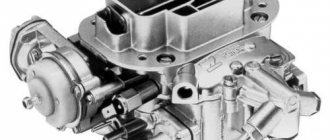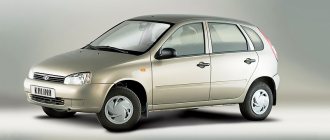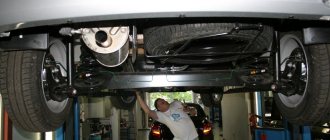Lada Largus is a Russian car built on the basis of the first generation Renault Logan MCV minivan. Initially, this model was called Dacia Logan, and was sold since 2006 in Romania. Production of the Russian modification began in 2011. Since then, the car has been produced virtually unchanged. However, unlike the original foreign car, Largus has several body versions. Thus, not only a minivan is available for sale, but also a commercial van, as well as an all-terrain version of the Largus Cross. In Russia, Lada Largus is considered the best-selling family car. The top-end version of the Lada Largus seats seven passengers and is also equipped with modern equipment and the ERA-GLONASS emergency warning system.
Fuel consumption of a 16-valve engine: Lada largus 16 mt 105 hp
If the driver has set himself the goal of determining the real level of fuel consumption of his LADA Largus station wagon, then for the purity of the experiment he will need to resort to such measures. Thanks to the spacious luggage compartment, I can place all my fishing gear, and my well-fed friends can sit comfortably in the spacious interior.
| Body type | City | Route | Mixed |
| Station wagon 7/5 seats, 16 cl. (K4M) | 10,1 | 6,7 | 7,9 |
| The same, 8th grade. (11189) | 10,6 | 6,7 | 8,2 |
| Van, 16 cells (K4M) | 10,4 | 6,4 | 7,9 |
| The same, 8th grade. (11189) | 10,6 | 6,7 | 8,2 |
New generation Lada. Lada priora
| Real fuel consumption of Lada Largus 16 valves - AutoTop A car engine with a power of 102 horsepower is equipped with 16 valves, so the fuel consumption rate of the Lada Largus per 100 km is characterized by an increase in its performance. The manufacturer notes that fuel consumption data was determined under standardized conditions using special measuring equipment, in accordance with the requirements of GOST R41. |
| What is the fuel consumption of the Lada Largus and on what factors does it depend? Fuel consumption on any car depends on a number of subjective and objective factors, ranging from the congestion of the route, the number of traffic lights along the way and the time of year, ending with driving style. The previous owner beat it up pretty badly, the engine was completely destroyed, the fuel consumption rate did not fit within any limits, besides, the engine ate oil, the exhaust gases had a pronounced black color. |
- Suppose that when driving along the highway, the BC showed a consumption of 7.4 liters. We find our configuration in the table, we see the number 6.7 there. Then there will be a proportion: 6.7 is to 7.4, as 10.1 is to X.
- The number X is 11.2 - this is the consumption rate in the city, but only for this car, for which the readings on the highway were “7.4”.
Reviews about the consumption of Lada Largus 16. 105 hp. • K7M unit with head design 1.
About choosing a filter
The oil filter on the K4M engine must be changed at every oil change. This requirement is more stringent than for 8 valves. On an 8-valve engine, the filter can be replaced “every other time,” although this is contrary to the regulations. But the 16-valve engine is not ready for such “difficulties”.
Articles
The Renault catalog contains two designations - 7700274177 and 8200768913. These are the article numbers for oil filters. But they differ - the first, “shorter” filter comes from the factory.
Filters 7700274177 (left) and 8200768913 (right)
Filter housing height:
- 7700274177 – 49 mm;
- 8200768913 – 53 mm;
- 7700873603 – 55 mm.
You can try the third option at your own risk.
New generation Lada
It's the same story with power. With a 105-horsepower engine, the Lada Largus's rated gasoline consumption per 100 km in the combined cycle is only 7.9 liters. For the 87-horsepower and 84-horsepower units, this figure is 8.2 and 9.3 liters, respectively. Fuel consumption is also affected by the working volume of the cylinders, but in this case it is equal to 1598 cm3 for all three engines. The actual fuel consumption of Lada Largus with different engines will also differ.
Owner reviews
- Arsen, Kirov. I bought a Lada Largus to use as a taxi; this car turned out to be very versatile and not at all gluttonous. I mainly take orders for cargo transportation, but even when there is not enough cargo transportation work, I can take passengers and, taking into account the fact that the average fuel consumption in the city is 11 liters, I will not go into the red.
- Andrey, Kostroma. I have a large family, so I was very happy about the appearance of a domestic station wagon with 7 seats, especially since the suspension and steering of the Lada Largus are the same as those of the Renault Logan, in other words, they are not fatal. Fuel consumption on the 84-horsepower Largus is also not quite high, which allows you to save money on the family budget.
- Vadim, Ussuriysk. I purchased a used 2014 Lada Largus car, and surprisingly, the fuel consumption rates were not too different from those declared by the manufacturer despite the solid mileage. Based on my calculations, I can say that in the city this workhorse rarely consumes more than 12 liters of fuel. Measurements on the highway gave a result of 7.5-8 liters of gasoline, depending on the condition of the road.
- Vasily, Nizhnevartovsk. I took a Lada Largus with an 8-valve engine from a friend at a reasonable price, because I knew that the car had been well looked after and had not been in accidents. As for fuel consumption standards, I can say for such a large car, and even one assembled at our plant, they are quite acceptable. Taking into account our harsh climate, when traveling to and from work in the city, I fill up with fuel at the rate of 13 liters per hundred square meters, and this is subject to 20-minute warm-up 2 times a day.
The car is equipped with a domestically produced VAZ-11189 unit; this Lada Largus has similar technical characteristics with an 84-horsepower engine. Data for this Largus model consumption will be slightly different:
- City limits - 12.4.
- Mixed cycle – 7.7.
- Route – 7.0.
As you can see, in free movement, despite the greater number of horsepower, the fuel consumption of the Lada Largus per 100 km of free highway is even lower than that of the 84-horsepower version.
Factors increasing gasoline costs
The main reasons for consuming more fuel are:
- Engine fuel consumption often increases due to low-quality fuel. This happens if you had to use the services of unverified gas stations or “filling up” with gasoline with a lower octane number.
- An important point is the use of additional electrical equipment or unnecessary track lighting. They promote the combustion of large quantities of gasoline in a short time.
- The driving style of the car owner is considered the main factor that affects the gasoline consumption of Lada Largus of all models. To avoid such problems, you need to drive smoothly and brake slowly.
Lada Largus fuel consumption rate, owner reviews
A reader asked whether fuel consumption was too high, that is, whether it complied with the standards. For the Lada Largus, fuel consumption standards are not given anywhere, just like for any other car. Now let’s look at how to use passport data:
Passport data regarding fuel consumption of Lada Largus
As follows from the technical documentation of the model in question, the volume of gasoline consumed on different types of engines according to the passport is somewhat different:
- for an eight-valve engine, the power is 84 hp. With. it is 12.3 liters per 100 kilometers in city driving mode, and 7.5 liters for the same distance when driving on the highway;
- for the same engine the power is 87 hp. With. this figure is 12.4 and 7.7 liters, respectively;
- for a sixteen-valve engine, fuel consumption will be 11.5 and 7.5 liters, respectively, according to the passport.
Advantages and disadvantages
- Saving fuel and lubricants. The 21129 engine has low fuel and lubricant consumption. Such indicators were achieved thanks to the new firmware;
- Increased power. The maximum engine power is 106 horsepower. When tuning, it is possible to increase this figure;
- Compliance with European environmental standards. More complete combustion of fuel in the chamber allows not only to improve technical performance, but also to increase the environmental class to the Euro 5 standard;
- Improved additional equipment. The manufacturer installed a modernized DC generator and improved mounting pads on the engine of the Lada X-ray and other models;
- Reliability and service life of the engine 21129. The manufacturer declared the service life of the power plant to be 200,000 km.
- When the belt breaks, the piston, moving to top dead center, bends the open valves;
- High cost of communication maintenance and repair due to the presence of expensive foreign-made parts;
- Poor quality of the cooling system thermostat. The engine takes a long time to warm up in the winter;
- The need to use high-quality fuel and expensive lubricants.
Let's consider the option with the K7M engine. Lada granta
When driving uphill, you need to engage a lower gear, because otherwise you will have to press the gas pedal to the floor in order to gain the required number of revolutions. The car had several body styles, including a van for transporting goods, a passenger version and two types of station wagon, with 5 and 7 seats, respectively.
| Model | Consumption (highway) | Consumption (city) | Consumption (mixed cycle) |
| Lada Largus | 6.7 l/100 km | 10.6 l/100 km | 8.2 l/100 km |
Real fuel consumption of Largus in urban conditions Lada largus 16 mt 105 hp
| Lada Largus fuel consumption per 100 km - basic norm and real Taking into account our harsh climate, when traveling to and from work in the city, I fill up with fuel at the rate of 13 liters per hundred square meters, and this is subject to a 20-minute warm-up 2 times a day . All electrical equipment that is turned on while driving takes on part of the generated energy, which can also become a factor in increasing gasoline consumption in a car of any brand. |
- City limits – 12.3.
- Mixed cycle – 7.5.
- Route – 7.2.
Lada Largus fuel consumption rate, owner reviews • Another consumption calculation is shown for mixed driving.
How are regulations regulated?
A vehicle requires fuel to operate. Each category of car requires different volumes of fuel and lubricants. The Ministry of Transport has developed a special standard - this is the fuel consumption rate for car brands. The standard allows you to determine how much fuel and lubricants a specific brand of vehicle requires to support the technological process.
The Ministry of Transport introduced the standards by a separate Order dated March 14, 2008 No. AM-23-r (as amended on September 20, 2020). The document establishes several categories of standards for fuel and fuel consumption:
- Basic standard for gasoline consumption in liters per 100 km in running order.
- Transport standard in liters per 100 km in operation (during transport work), including:
- cost standard for a bus taking into account curb weight and nominal passenger load;
- consumption standard for dump trucks, taking into account equipment and nominal vehicle load.
- Transport standard for a truck in liters per 100 ton-kilometers, determined during transport work.
Standards are set in liters, for example, for gasoline or diesel fuel. Or the standards are fixed in cubic meters if, for example, transport consumes gas.
New Lada: Garant Bastion anti-theft ignition switch for Lada, Renault, Nissan
Fuel consumption on the highway
Let us remind fans that the Lada Largus is a small-format universal “state car”, which was developed by AvtoVAZ with the direct participation of specialists from Renault-Nissan. This is reflected in the appearance of the car, since it is a derivative of the popular modification of the Dacia Logan MCV. The positive aspect of the universal “Russian” is its adaptability to domestic road conditions. This car can please you with its spacious interior, modern body design and spacious luggage compartment. It is these qualities that today form the basis for the priority of a car over the category of practical owners.
About reducing fuel consumption during the running-in process
When measuring fuel consumption, the manufacturer uses new cars and a certain type of route. However, as the mileage increases, the amount of fuel required per 100 kilometers changes. Most often, a more economical situation is noted.
So, for example, for a range of up to 30,000 kilometers, the rate of fuel consumption for every 100 kilometers is 9.3 liters. If we take the same route, but the car’s mileage will be twice as long (60,000 kilometers), then the consumption rate will decrease and will be 8.3 liters. Such figures make it possible to determine at what point the vehicle's running-in was completed.
Thus, at this stage, fuel consumption, regardless of the type of body (station wagon, van), will always be higher than after the end of the run-in.
The main reasons for consuming more fuel are:
The 105-horsepower engines of the Lada Largus in mixed mode consume 9-10 liters of gasoline per 100 kilometers, when driving around the city up to 13 liters, and on the highway, judging by the reviews of the owners, the figure ranges from 7 to 9 liters. A review of numerous reviews from the owners of this car has the following results: city driving consumes 12.5 liters, country driving about 8 liters and in the combined cycle 10 liters.
Cooling system
The motor is equipped with a forced-type liquid cooling system. Cooling of the liquid is carried out in the radiator. The movement of coolant in the radiator and cooling jacket is carried out using a water pump. It is belt driven from the crankshaft of the power unit.
For quick warm-up in the cold season, a thermostat is included in the cooling system. At low coolant temperatures, the thermostat closes a large circulation circle. This allows for rapid heating of the coolant. Once the required temperature is reached, the thermostat opens a large circle.
Largus with the domestic unit “11189”. Lada granta
| Fuel consumption rate for Lada Largus - Automobile Magazine If the fuel consumption standards for a vehicle depend on the technical characteristics of the model: engine power, number of valves, cylinder volume, then actual consumption is related to. For Lada Largus cars, real gasoline consumption outside the city is 6.7 -7.2 liters per 100 kilometers; according to technical documentation, it is within the range of 6.4 - 6.7 liters per 100 kilometers. |
| Fuel consumption of Lada Largus: engine characteristics Press the button on the dashboard, turn on the ignition without releasing the button, wait until all the lights on the display light up and the instrument arrows start dancing. 6 liters, its assembly is carried out at facilities located in Romania and a car with such an engine is capable of reaching a maximum speed of 155 km h. |
- Suppose that when driving along the highway, the BC showed a consumption of 7.4 liters. We find our configuration in the table, we see the number 6.7 there. Then there will be a proportion: 6.7 is to 7.4, as 10.1 is to X.
- The number X is 11.2 - this is the consumption rate in the city, but only for this car, for which the readings on the highway were “7.4”.
Standard • Engine 16l 106l 21129
I bought a 2011 car, just off the assembly line, and I don’t regret anything, parts are always available in any store, although breakdowns do not happen often if the main components are serviced in a timely manner. Just like the previous power unit, this engine is paired with a 5-speed manual gearbox and can accelerate the car to a maximum speed of 155 km/h.
| № | Positive |
| 1 | Andrey (Avtodrom): I’ve been driving carefully for three years now and systematically carry out maintenance. I heard about the valve problem. I think that a lot depends on the driver. |
| 2 | Sergey (Avtotema): I have a 16-valve engine, the pickup from the bottom is weak, but on the highway the engine is a “beast”, I have no complaints about the internal combustion engine, I’m happy with the purchase. |
| 3 | Kirill (Autoreview): the engine has driven 65,000 km and is normal; at every service I carry out diagnostics. |
| 4 | Alexey (Avtoria): unlike Granta, Vesta is more powerful, with a good pick-up. I'm glad for the domestic manufacturer. |
| 5 | Alexander (Drom): my positive review of the VAZ 21116, four years of active use without any comments. |
| 6 | Stanislav (Driving): I have no problems with the car, the mechanisms are working normally. |
| 7 | Vasily Alekseevich (“5th wheel”): at 50,000 km the alternator belt began to whistle, tightened it. The valves do not knock, the engine runs smoothly. |
| Negative | |
| 8 | Vitaly (Avtotema): recently the belt drive broke, fortunately it reacted with lightning speed, the valves were not damaged. |
| 9 | Svyatoslav (Otzovik.net): when they broke, the first and third pistons were deformed, replaced them with new ones. The repairs weren't cheap. |
| 10 | Vlad (ProAuto): I regret that I bought Vesta with a domestic engine, my comrades advised me to buy it with a Renault engine. |











